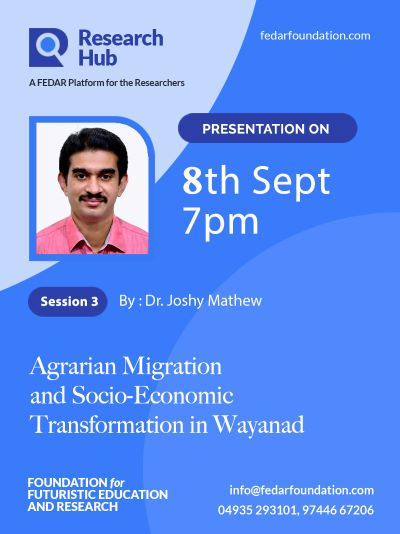Agrarian Migration and Socio-Economic Transformation in Wayanad

Thesis paper by : Dr. Joshy Mathew
Presented on : 08-09-2021
Summary
Agrarian Migration to Wayanad: A Socio-Historical Perspective 1928-2000
Migration of people from one place to another for various reasons is a common phenomenon in the world since time immemorial. The movement of people from one place to another is forced by many push and pull factors in different circumstances. This study deals with the migration of small scale farmers from Central Travancore region of Kerala to the hill tracts of Malabar especially Wayanad in search of land for agriculture. The chief provenance of farmers were Meenachil, Thodupuzha, Muvattupuzha and Vaikkom taluks of Kottayam division and they settled in the hilly region of Kozhikkode, Kannur, Wayanad, Malappuram, Palakkad in Malabar. I have selected Wayanad for this study on account of the high concentration of farmers in this region. Though the participants of this agrarian migration consisted of all sections of the people, it was dominated by Syrian Christians of Travancore. After Second World War, due to famine and poverty people moved to Wayanad in large scale and settled in the abundant land available in Malabar.
The famers purchased land from the individual landlords and Devaswams on lease by paying Manusham. They have paid annual rent to the landlords either in cash or in kind. The early migrant farmers have encountered with severe hardships in Wayanad like Malaria, severe cold, attack of wild animals, exploitation of money lenders and so on. Hundred of farmers died due Malaria between 1940 to 1960. Numerous migrants returned to Travancore when they lost their wealth and family members in Malabar. Wild animals not only attacked the farmers but also destroyed the crops of farmers in large scale. Because of the lack of medical facilities people died even due to minor illness. But their hard work and persistence led to overcome all the difficulties in the new land. They have transformed the thick abandoned forests into agricultural farms with all crops. Paddy, lemongrass, pepper, ginger, coconut, coffee, areca nut etc. were cultivated that yielded high return to farmers. Agrarian migration and subsequent production of cash crops resulted great economic prosperity of Malabar.
In the hill tracts of Malabar, a new community formation had occurred based on parishes under migrants from Travancore. In the undeveloped areas of Malabar, these farmers took lead for the all round development the region. Parish committees in various names were formed and mobilized economic and infrastructure resources for the developmental activities. They have established educational institutions like schools, colleges, hospitals roads, bridges, banks, cooperative societies, clubs and many other institutions. These poor farmers started all these modern amenities in the hills of Wayanad without the support of government or other agencies.
The construction of wide network of roads by the migrants significantly improved the transport and communication facilities in the colonies of migration. The migrant leaders were at the fore front in bringing various government offices in hilly tracts of Malabar. The tribal people of Wayanad were also benefited by the coming of migrants. Their age old bonded labour under the native landlords came to an end when they began to work for migrants. Unlike others, migrants began to wage to the tribal labourers in cash and shared food with them. The natives and tribal people adopted new food and dress habits of migrants of Travancore. This brought a cultural change among them in Wayanad. By 1980 the migration farmers almost ended completely. In short, Wayanad is greatly indebted to agrarian migration from Travancore for her present status.






 Corehub Solutions Pvt. Ltd
Corehub Solutions Pvt. Ltd